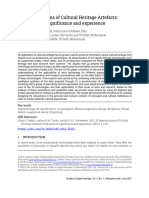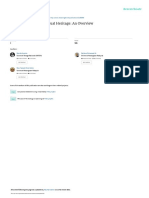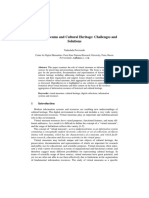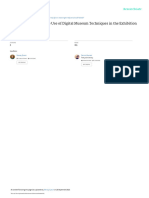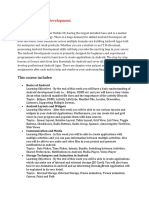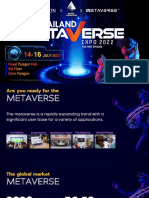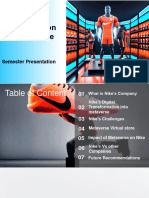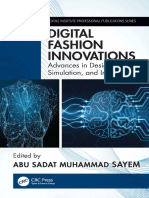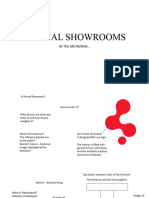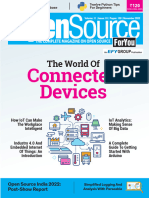Integration of Digital Repositories and Spatial Design
Uploaded by
Lucas Meiado SouzaIntegration of Digital Repositories and Spatial Design
Uploaded by
Lucas Meiado SouzaThe International Archives of the Photogrammetry, Remote Sensing and Spatial Information Sciences, Volume XLVIII-4-2024
ISPRS TC IV Mid-term Symposium “Spatial Information to Empower the Metaverse”, 22–25 October 2024, Fremantle, Perth, Australia
Integration of Digital Repositories and Spatial Design within the Metaverse: the Evaluation of
Features and Narratives to set Learning Environments on Cultural Heritage
Raffaella De Marco
DICAr – Dept. of Civil Engineering and Architecture, University of Pavia, 27100 Pavia, Italy – raffaella.demarco@unipv.it
Keywords: Metaverse, Digital Heritage, Virtual Repositories, Cultural Narratives, Learning Environments, Spatial.
Abstract
The Metaverse is rapidly advancing across cultural, professional, and service sectors, enhancing data compatibility and interaction. Its
architectural design supports both visual interaction and information layers, characterising an ideal platform for the promotion of
Digital Heritage. The digitisation of Cultural Heritage and the creation of Digital Repositories find complementarity in the Metaverse,
which enables social interactions between Digital Heritage contents and virtual communities. This integration is pivotal for developing
Learning Environments, where accessible virtual products can be combined with original digital storytelling and narratives.
The paper presents methods and results from an Erasmus+ international school, which focused on using digital communication and
3D modelling tools to create immersive narratives on Mediterranean architectural modernity. Students from various Cultural Heritage
disciplines designed virtual exhibitions within the Metaverse platform Spatial and open repository materials. The research concentrated
on the application of Metaverse platforms for their spatial design and educational utility within the Heritage sector. The activities
included developing digital narratives and interactive exhibitions enriched with multimedia data from digital repositories. The study
discusses the limitations of customising visual materials, the importance of repository connections, user experience design, and the
potential for future developments in Metaverse applications for Cultural Heritage learning environments and storytelling.
1. Introduction through the “container” (Metaverse) (Tlili et al., 2022; Al-Tabeeb
and Al-Desouqi, 2023).
The field of Cultural Heritage is increasingly taking part in the The scientific relevance is highlighted in the advancement of
research perspectives linked to the mission of the Metaverse. The Learning Environments from Digital Heritage (Gaafar, 2021;
transition to Digital Heritage has been underway for decades, Lee, 2023): the availability and accessibility of heritage virtual
driven by emerging considerations of accessibility, fruition, and products (Chong et al., 2021; Parrinello and De Marco, 2022) in
preservation of tangible and intangible heritage within the web space can be combined with the design of digital
opportunities of digital transposition and archiving (Burkey, narratives and story-telling collections, taking advantage of the
2022). Thus, scientific research has concentrated on studying Metaverse dimension (Cruz et al., 2022; Gonçalves et al., 2022).
methodologies for both the visualisation and interaction of Cultural storytelling through the tools of Virtual Reality can be
physical heritage and information contents in the intangible adopted in different declinations, experimenting with the types of
dimension of Digital Twins (Ott and Pozzi, 2010; Paladini et al., interactions between the users and the storyteller (Buhalis and
2019). It has resulted in a multiplicity of digital data and virtual Karatay, 2022), who also can be the designer of the narrative
products, especially 3D point clouds and virtual models, space. In this case, an accessible workflow of spatial design and
produced by specialised research in digital documentation and management of 3D virtual artefacts has to be considered.
surveys with exponential technical improvement. The application
of digitisation workflows (Balletti and Ballarin, 2019) is 2. Background
becoming increasingly efficient, expeditious and multi-
instrumental, especially relating to the use of 3D To contextualise the scientific discourse of integration between
photogrammetry as a fast, low cost and accessible methodology Metaverse and Digital Repositories, it is important to outline a
for the production of reality-based virtual models. At the same background of how these applications are currently developed
time, platforms and online repositories are expanding and and used concerning Cultural Heritage digital contents and
affirming a standard for the collection and open access to such formats. Furthermore, ongoing examples of how museums and
digital data (Champion and Rahaman, 2020). They are combining cultural organisations are experimenting with their adoption into
archiving and fruition to options for the management and proper facilities are central to understanding the potential of
traceability of digital data, expanding the modalities of development and the aims of the scientific debate.
interaction and association to multiple dimensions of information
and research (King et al., 2016; Champion and Rahaman, 2019). 2.1 Digital Repositories for Cultural Heritage
For these purposes, the Digitisation of Cultural Heritage and the
consequent production of repositories of its digital products can The practice of digitising Cultural Heritage artefacts, at different
find an “indigenous” complementarity in the application through scales and different sectors, has focused on how to organise and
the Metaverse. Formats and languages, both digitally and preserve such materials from a perspective of sustainability,
ontologically, are natively compatible. Furthermore, advanced accessibility, and reapplication of data. Digital Repositories have
social interactions can be established between the “contents” assumed the value of proper “libraries”, developing codes and
(Digital Heritage data) and the wider community of virtual users instructions for “cataloguing” such materials, adopting metadata,
This contribution has been peer-reviewed.
https://doi.org/10.5194/isprs-archives-XLVIII-4-2024-147-2024 | © Author(s) 2024. CC BY 4.0 License. 147
The International Archives of the Photogrammetry, Remote Sensing and Spatial Information Sciences, Volume XLVIII-4-2024
ISPRS TC IV Mid-term Symposium “Spatial Information to Empower the Metaverse”, 22–25 October 2024, Fremantle, Perth, Australia
and working even more on accessibility and interaction tools for principles for data management and R4 goals (Re-usable,
users towards the same archive and through third platforms. Relevant, Reliable and Resilient) direct the creation of formats of
Compared to initial versions, repositories have progressively descriptive metadata for digital resources (Fig. 2) (Sotirova-
evolved in the characteristics of Web 3.0 (3D and semantic web) Valkova, 2020; Barbuti, 2021).
and Web 4.0 (compatible with Extended Reality and real-time
interaction for the digital alter ego) (Ghani et al., 2020). From a
critical analysis of online repositories (Champion and Rahaman,
2020), it is possible to observe the characteristics and interaction
properties that are offered for Digital Heritage concerning the
type of parties/actions entrusted with the main development of
the repository and the offered type of data formats. In some cases,
the repository is limited to the interactive use of data, offered as
virtual tours or spot information (e.g., CyArk, Smithsonian 3D
and other public/private museums). Otherwise, options are
offered to the user to customise the use of data, creating at the
same time original and creative sub-themes for the educational
and cataloguing enrichment of the repository provider (e.g.,
Europeana and its building tool for “Galleries”) (Fig. 1)
(Giannakoulopoulos et al., 2021; Macrì and Cristofaro, 2021).
Figure 2. SketchFab platform, with 3D interactive virtual
models, geometric quality and information implementation to
promote indexing and reuse of the data (“MOEBHIOS” Horizon
Europe project, MSCA Fellowship, 2022).
Thus, it activates a continuous mechanism of enrichment of these
repositories, which through the service brand also remain up to
date in terms of the quality of the digital data and its adaptability
to the virtuality and interactivity of the growing web platforms,
finalised by the Metaverse landscape.
2.2 Metaverse development towards Learning purposes
The empowerment of Metaverse is proceeding exponentially,
interesting multiple cultural, professional, and service spheres. In
addition to the main core of Gaming function (e.g., Core Game,
Zepeto, Fortnite, Rec Room, Sinespace, Avakin Life), a second
main application of Virtual Interaction is highlighted in the core
platforms aimed at the virtual socialisation of community users
(e.g., Vesta, Sansar, Stageverse, Open Simulator, Gaia Online,
Figure 1. Europeana platform, with a Gallery dedicated to 3D
Spatial). Other platforms showed more specific declinations to
models for Cultural Heritage (“Twin it! 3D for Europe’s culture cater for a defined and sectorial niche audience (e.g., Wave for
campaign”, European Commission and Europeana, 2023). virtual concert events entirely hosted in the Metaverse, Wooz
World and Imvu for fashion and styling business virtual events).
Furthermore, there is the case of repositories built through the According to the main function assumed by the Metaverse
provision of services and the construction of communities that platform, the possibilities of compatibility and interaction of
performed proper crowdsourcing actions in populating the different formats of data are expanding the characterisations of
repository itself (e.g., Sketchfab, 3DHOP). In this case, the its “architectural design” (Duan et al., 2021). It involves the
service platform generated the construction of the repository at attention to practicable solutions both in the visual “interaction”
the same time as the service application by the clients, who are layers of the Metaverse environment and in the sub-present
primarily in charge of generating, uploading, and implementing “information” layers of metadata and ontologies, even externally
Digital Heritage products and their metadata. The platform is referenced. It is suitable to connect the Metaverse application to
responsible for supervising and indexing the uploaded data, the concept of Virtual Learning Environments, as virtual spaces
guaranteeing not only a private service but also a public impact for learning, interaction and consultation of educational contents,
and value to the web community in the construction of the exchange of information and sharing of materials. They are
branded “gallery”. In this role of supervision, FAIR guiding meant for the creation and management of a more effective
This contribution has been peer-reviewed.
https://doi.org/10.5194/isprs-archives-XLVIII-4-2024-147-2024 | © Author(s) 2024. CC BY 4.0 License. 148
The International Archives of the Photogrammetry, Remote Sensing and Spatial Information Sciences, Volume XLVIII-4-2024
ISPRS TC IV Mid-term Symposium “Spatial Information to Empower the Metaverse”, 22–25 October 2024, Fremantle, Perth, Australia
learning ecosystem based on digital tools and interactions for perspective of Cultural Heritage preservation, allowing them to
personalised supervision of educational time and users’ attitudes, interact with content not just passively but by leaving their active
in this case regarding Cultural Heritage (Ibrahim and Ali, 2018; contribution in the form of quests, questionnaires, or other
Megan et al., 2021; Parrinello and De Marco, 2022). collaborative information release. At the same time, users are
From a technical point of view of platform implementation by encouraged to participate by receiving virtual content as a free
creators, the approach to the Metaverse increasingly follows reward in return (Xia et al., 2023).
interfaces common to web design. At the same time, specific The MET Metropolitan Museum of Art (New York, 2023) has
design in increasingly defined “architectural terms” of the set up MET's Replica system, which through an app offers a
simulated space is implied, especially when the main function is Learning Environment based on the discovery-reward system,
assumed related to the educational sphere (Tlili et al., 2022). To imitating the basic principle of gaming. Jake Vordun with its
facilitate the human perception of the user for location and Vordun Museum & Gallery (2016) provides on Second Life a
orientation as background to learning attention in the virtual digital replica of exhibits with dynamic settings, and the British
space, Metaverse environments originate fundamentally from Museum, in partnership with the Metaverse platform The
“mirror worlds”, inspired by cultural social virtual environments Sandbox, has anticipated a service to enrich educational
such as museums and exhibitions (Giovannini, 2024). Within opportunities and provide history and culture with a brand-new
them, alterations are made possible by the Extended Reality way to engage with the museum’s collections (London, 2024).
format, as spatial paradoxes, and augmented dimensions of Furthermore, interactivity and engagement are highlighted in
information between users, space and contents. NABIYA unveiled Maison NABI Haetera by the Musée des Tissus
& les arts décoratifs of Lyon (2023), structured as an online
2.3 Metaverse adoption in the educational/cultural sector gamified experience of silk-making art.
Museums and exhibition services are increasingly interested in 2.4 Aims and Objectives
their service development in the Metaverse, in the perspective of
the digital transition of their collections and in developing a new As the demand for digital services is growing in the cultural
attraction of the public to creative exhibition themes and media, sector, it becomes central to work facing a related search for
especially through tools of Web 4.0 (Lu et al., 2023; Longo and resources and expertise to establish a robust digital presence of
Faraci, 2023). A cultural theme can be declined in a playful cultural institutions and content in the Metaverse, relying on
dimension of an immersive and interacting virtual environment, expertise and professionals. An opportunity is considered to
as the re-imagination of a narrative story (Curious Alice: the VR include these topics in the didactic and research experience of
experience, 2021, Victoria & Albert Museum). As well, it can transversal fields from Cultural Heritage education. At the same
also be developed concisely and interactively through “modular time, a limitation is seen in the demand for technical skills in
spaces” for 3D immersive exhibitions (Pocket Galleries, Google modelling and management of virtual environments, which are
Arts & Culture, 2021) (Fig. 3). specific to some curricula such as engineering and architecture
but unfamiliar in the social sciences and the fields of landscape,
tourism, museum management and cultural heritage policy.
The research framework aimed to evaluate a workflow for the
design and management of exhibition/museum models as
Learning Environments in the Metaverse, considering in parallel
both the suitability of the platform to host this type of project and
the extent of the digital languages required for its programming.
The objective pursued was to test through a didactic activity the
familiarity of students from both humanistic and technical
disciplines with the Metaverse landscape, and to push them to
translate their knowledge of design for Cultural Heritage
narratives into the terms of a virtual and interactive dimension.
Preliminary to the didactic experimentation, scientific research
included a critical analysis of the main Metaverse platforms,
identifying features and requirements available to enhance its
cultural application, user experience and programming language.
The analysis was aimed at reviewing the present-day
applicability of Metaverse platforms to the non-strictly
entertainment function, such as the design of Learning
Environments from the educational perspective. and selecting the
pilot environment for experimentation.
3. Materials and Methods
Figure 3. Google Pocket Galleries, interaction and cultural
narratives in 3D spatial storytelling (Google Arts & Culture, The paper presents the methods and results developed through an
international Summer School co-funded by the Erasmus+
https://artsandculture.google.com/project/pocket-gallery).
programme. It was addressed for adopting didactic tools of digital
communication and modelling practices of immersive 3D
The dimensions of impact envisaged by museum institutions are scenarios for the narration of cultural multimedia content on the
multiple and developed both in terms of audience and narrative Mediterranean heritage of Architectural Modernity. The
characterisation. The potential of reaching a global audience has activities experimented with a didactic opportunity to allow
an impact in terms of accessibility, resolving both geographical students from different fields related to Cultural Heritage
and physical constraints. The interactivity offered by the (architecture, engineering, landscape, arts, history, economics) to
Metaverse also allows visitors to play a crucial role in a new develop the basis of a Learning Environment in the Metaverse,
This contribution has been peer-reviewed.
https://doi.org/10.5194/isprs-archives-XLVIII-4-2024-147-2024 | © Author(s) 2024. CC BY 4.0 License. 149
The International Archives of the Photogrammetry, Remote Sensing and Spatial Information Sciences, Volume XLVIII-4-2024
ISPRS TC IV Mid-term Symposium “Spatial Information to Empower the Metaverse”, 22–25 October 2024, Fremantle, Perth, Australia
selecting a narrative topic and designing a virtual interactive branded functional particularities, such as Wave or Stageverse for
exhibition, also with the support of data from open repositories. hosting virtual concerts, or Wooz World for fashion events and
The research experience was developed in two phases. Phase 1: exhibitions. In the research aim, platforms dedicated to Virtual
preliminary research for assessing the state-of-the-art of the most Interaction have been preferred to pursue the objectives of
available Metaverse platforms, and evaluating their features of designing Learning Environments and cultural narratives.
spatial design and user experience concerning educational
purposes and didactic experience. Phase 2: practical didactic Cultural adoption: declination of the platforms to environments
activity with students, as an international workshop structured on and/or content from the cultural sector. The evaluation was
theoretical lectures and laboratory tasks, aimed at the conducted by considering existing examples, where the content
development of digital narratives and Learning Environments and modalities of navigation and interaction demonstrated a
from the analysis of Modernity in Architecture across the dedicated focus on the educational and cultural experience. Some
Mediterranean. platforms showed experiences already implemented and open to
the public (e.g., Mozilla Hubs, Sansar, Stageverse, Cluster,
3.1 Architecture of the Metaverse platform: analysis and Minecraft, Spatial).
features evaluation for Cultural Heritage experience
Interaction with Cultural Heritage Open Repositories:
In Phase 1, a critical analysis of the main Metaverse platforms predisposition of the platforms to interconnect with Open
was conducted, starting with those mentioned by the Metaverse Repositories on the web, dedicated to Cultural Heritage content.
Observatory in its Map of the Metaverse (2022). An existing This feature was traced in just a few cases from the platforms list,
classification of Metaverse by the seven layers has already been in particular for Mozilla Hubs and Spatial, and in both cases, it
addressed (Infrastructure, Human Interface, Decentralisation, regarded compatibility with the SketchFab platform.
Spatial Computing, Creator Economy, Discovery, and
Experience) (Wang et al., 2022). However, the present research Data/Multimedia Integration: it was assessed the feasibility of
has introduced novel key points, defined as features, in the inserting external data and multimedia (images, GIFs, videos),
perspective of the application of the Metaverse technology to the also from web sources (e.g. YouTube), into the platform and
development of Learning Virtual Environments in the sector of integrating them into the design of the virtual environment as
Cultural Heritage. interactive content, suitable into the designed narrative path.
Metaverse Environments have been compared by establishing a External links, both display-only and questionnaires, were also
list of key features considered central for (i) applying the design considered. Only a few platforms showed this compatibility (e.g.,
of the Metaverse to the cultural/educational narrative function; Mozilla Hubs, Stageverse, Sinespace, Spatial).
(ii) working in synergy and sustainability of the use of open
repositories of digital material on Cultural Heritage; (iii) adopting Social Interaction: this feature assessed the quality of interaction
no-specialised options and tools for managing the design of virtual users both concerning the contents of the environment
component of the environment and user interactions; (iv) making and other users engaged in the same visit. The possibility of
the generation and management of the system available for users interacting with other users to exchange impressions, opinions,
from not only technical sectors related to Cultural Heritage. and dialogues, especially in real-time, towards the same
The features evaluated in the critical analysis concerned this list. experience of information or visibility of cultural artefact was
considered. The opportunity to leave comments and information
Core function: specific functional scope of the platforms. beyond the time of the visit was considered, but in this case, it
Predominantly they are divided into two functions, Gaming (e.g. was classified in the previous category in terms of data
Core Games, Zepeto, Fortnite, Avakin Life) and Virtual integration with respect to the native Metaverse environment. As
Interaction (e.g. Mozilla Hubs, Vesta, Sansar, Spatial), in some the main quality of the Metaverse's technology, all the analysed
cases in a mixed format. Other platforms highlight specific and environments presented optimal conditions for this feature.
Figure 4. Critical analysis of the main Metaverse platforms considering key features selected for the objective of designing of
social immersive environments for cultural narratives and interactive Learning Environments (Images developed by the Autor).
This contribution has been peer-reviewed.
https://doi.org/10.5194/isprs-archives-XLVIII-4-2024-147-2024 | © Author(s) 2024. CC BY 4.0 License. 150
The International Archives of the Photogrammetry, Remote Sensing and Spatial Information Sciences, Volume XLVIII-4-2024
ISPRS TC IV Mid-term Symposium “Spatial Information to Empower the Metaverse”, 22–25 October 2024, Fremantle, Perth, Australia
Spatial Design facility: this feature analyses how the 3D space avatar, and activating a camera with both subjective and external
hosting the educational environment in the Metaverse is created views (Fig. 5). Among the platform collaborative opportunities,
and managed. Several qualities were evaluated, such as the there is the possibility of creating and managing teams between
provision of starting by adopting spatial templates, the modelling users, who can be logged in simultaneously in real-time in the
of the 3D space directly via the web and not through external same spatial asset and operate at the same time in the
platforms; the virtual ‘physical’ limitations to the setting up of management, editing and setting up of content and options.
architectural and exhibition components for the spatial design; Autosave is enabled by the platform, with a synchronous
the formats and design sets available for the digital learning modality between the different editing users connected.
contents and materials; the availability of abacuses and galleries
of furniture elements or the connection to external galleries for
their use. Not all the Metaverse platforms analysed have shown
compatibility, and among those available, some showed extreme
limitations to the qualitative design of virtual space. Among the
most suitable were Mozilla Hubs, Sansar, Cluster, Sinespace,
Spatial and Open Simulator.
Software requirement: this feature assessed the need for installing
software components for the design of the Metaverse
environment, or the possibility of working directly with the hard
drive on the online platform, in stand-alone mode, without added
components. This feature is relevant to allow the workflow to be
accessible to non-professional users in 3D modelling and virtual
reality, and it also facilitates hard drive use and training tasks,
just relying on the web connection band. Few Metaverse
platforms have proven to be able to operate in web stand-alone
mode, e.g. Mozilla Hubs, Stageverse, Gaia Online and Spatial.
Advanced Scripting: also, this feature assessed the need for
advanced computer language and programming skills to be able
to operate in the virtual environment and contents management.
It was highlighted that at least half of the Metaverse platforms
require such skills, which are uncommon in several academic and
professional fields related to Cultural Heritage. Advanced
scripting is not fundamentally required in e.g. Hiberworld,
Stageverse, Roblox, Gaia Online, and Spatial.
From the following considerations (Fig. 4), the environment of Figure 5. Spatial platform: spatial templates and starting asset.
Spatial (Metaverse, 2016) has been evaluated as the feasible and
adaptable choice to be applied for the didactic experimentation. The ‘Content’ input tool introduces the categories of materials
and data that can be set up in the virtual environment, with
3.2 Design of Learning Environments in the Metaverse: standard galleries of ‘Stuff’ and ‘Supplies’ and a direct link to
Heritage scenarios and practical tools Sketchfab via user login. Similarly, NFTs and other models’
templates or upload materials can be activated and imported, also
Phase 2 included the workshop activities of the International synchronised by Google Drive.
Summer School, conducted in September 2023. The school The insertion of an artefact from SketchFab highlights two sets
aimed to encourage students to research original ideas of of properties: the possibility to move, rotate and scale the object
storytelling about Modernity in Architecture. They could also in the virtual space (‘spatial control’) and the availability of an
take advantage of their multi-national background (Italy, information label that keeps the artefact uniquely connected with
Portugal, Germany, Palestine, Ukraine, Serbia) to build a wider the proprietary information from its location in SketchFab
dialogue and comparison of knowledge and case studies. (‘metadata control’). This tool expresses utility and quality in
Theoretical lectures on architectural archiving and analysis, promoting the FAIR guidelines of digital data use (Fig. 6).
digital data on Cultural Heritage, Metaverse applications, In addition to 3D models, it is possible to insert multimedia
Cultural Heritage values, promotion and communication were material, either by exploiting surface content ‘panels’, arranged
introduced. Then, the participants followed the laboratory on the walls, or by creating new ones and applying them within
sessions and applied their knowledge to the design of a shared the scene. Design solutions can either be tracing the surfaces or
virtual environment, setting the space in Spatial and using adopting them as new design components of the virtual space.
original data or open access contents from SketchFab gallery. Images, cached videos, or videos from the web (e.g. YouTube)
can be loaded onto these formats. Images are also adaptable in
Spatial platform offers free starting templates of 3D spatial assets terms of QR codes or interactive links, associated with personal
already disposed of interactive tools, some already designed in labels, to connect tools of interactive participation or survey.
the format of exhibition galleries or museum spaces. The assets As interaction functions, Spatial offers both standard ‘emoticons’
have a preset disposition of 2D panels for content insertion. and avatar reactions, as well as the ability to interact directly via
Furthermore, it is possible to implement them or to create new chat or microphone and camera controls or to produce interactive
spaces through a more advanced modelling toolkit, operating experience content with Filming tools. The virtual environment
through compatibility with the Unity platform and C# language. can be shared through links, managing user or visitor roles, and
The design of the scene takes place in web-based online mode, using the ‘Live’ Highlight to connect broadly to the Spatial
navigating in real-time in the virtual space through a personal community and be promoted through the platform.
This contribution has been peer-reviewed.
https://doi.org/10.5194/isprs-archives-XLVIII-4-2024-147-2024 | © Author(s) 2024. CC BY 4.0 License. 151
The International Archives of the Photogrammetry, Remote Sensing and Spatial Information Sciences, Volume XLVIII-4-2024
ISPRS TC IV Mid-term Symposium “Spatial Information to Empower the Metaverse”, 22–25 October 2024, Fremantle, Perth, Australia
Selected themes developed comparisons across countries and
cultures, such as between Ukraine, Italy, and Palestine on the
endangered heritage, or between Palestine, Egypt, and Portugal
in the influence of modern style between broader architects.
Other projects have experimented with the ‘mirror-space’
reproduction of famous architectural environments from
Modernity, while developing the multidimensional opportunity
of the virtual platform to convert architecture beyond three
dimensions and introduce alternative information content and
visiting paradoxes to the physical experience, such as mazes or
hidden doors.
The adoption of gallery elements made it possible to work not
only on the educational content of the visit. It also allowed to
combine the original design of the virtual spaces, denying
physical constraints, with impossible and therefore
unprecedented solutions for setting up and communicating the
cultural content. Some spatial environments have been designed
with projection sections, playing on the possibility of avoiding
sitting spaces or crowding users, who in the virtual paradox don’t
need more time and effort to visit than the real visitor placed in
front of the remote device. Other sections were transformed from
interiors to exteriors, adding a more complex design of virtual
content and activity rooms, where the virtual user can be both a
spectator and actor of the scene, in a public relation with the
virtual community.
The results and virtual environments are presented in Fig. 7 and
can be visited directly through the associated QR codes. The use
from a smartphone or tablet device involves an internet
connection and the installation of a supporting app to conduct the
immersive visit, automatically relinked from the device.
5. Conclusions
Considerations are conducted from the discussion on the results
and the future assessment of impact and feedback from the
Learning Environments integration and experience. In this way,
it provides the basis for developing a debate on the future
opportunities of research and the next developments of the
Metaverse environments for the implementation of cultural
narratives and educational purposes in Cultural Heritage. The
main points of debate are the followings.
(i) Limitations to customised uploading of visual material and
relevance in the connection to online Open Repositories: this
feature needs to be expanded, with a focus on interconnecting the
Metaverse to public databases and other collections available on
Figure 6. Tools, assets, and galleries for the spatial design in the web. With attention to data protection and FAIR guidelines,
Spatial platform of Metaverse experience progress can be done to extend this network, taking advantage of
the native compatibility of data formats and materials. For
4. Results instance, the connection with Europeana and its galleries, both
for 2D and 3D artefacts, can be a first but decisive targeted step.
During the activities of the International Summer School, the (ii) Design and user experience feedback related to the
participating students worked in mixed international groups, modalities of virtual fruition and Metaverse interface: the
designing 8 virtual environments on the Spatial platform. From collection of feedback and opinions from the experience of the
the assumption of a thematic path and an assessment of heritage designed environments can allow the identification of factors for
values for the communication aim, they were responsible for the improvement in the educational perspective. For the paper’s
insertion of content and for the management of the interactive results, questionnaires are collecting data for future analysis.
experience, with the aim of producing original cultural narratives (iii) Social interaction tools and sharing features of the Learning
on topics related to Architectural Modernity. Environments in the perspective of future developments for the
The use of 3D components, images, and videos, coming from a Cultural Heritage field: the aim of making the virtual museum
systematic action of analysis and use of archives and databases, increasingly interactive and socially responsive is of broad
and the design properties of the virtual space made it possible to interest. In particular, the collection of memories, documents,
work on the objective of both the thematic information shared oral histories are central in the integration of digital storytelling.
and the virtual user experience. It enabled the construction of Through the Metaverse, such action can be conducted remotely,
360° immersive learning environments that also involved the connecting people and contributors to cultural content even if
design of sensations and perceptions experienced during the they are physically distant. High relevance is linked to cultural
virtual visit, calibrating sounds and lighting of the environment. communities living to present diasporas or cultural clustering.
This contribution has been peer-reviewed.
https://doi.org/10.5194/isprs-archives-XLVIII-4-2024-147-2024 | © Author(s) 2024. CC BY 4.0 License. 152
The International Archives of the Photogrammetry, Remote Sensing and Spatial Information Sciences, Volume XLVIII-4-2024
ISPRS TC IV Mid-term Symposium “Spatial Information to Empower the Metaverse”, 22–25 October 2024, Fremantle, Perth, Australia
Acknowledgements
Research purposes, methods and results have been developed
through an international summer school funded by BIP Blended
Intensive Programme through the Erasmus+ programme. The
BIP - Intensive International Summer School 2023 "VERY-M
Valuing challEnges on aRchitectural tYpologies – Modernity"
was coordinated by the University of Pavia (UNIPV), in a
partnership composed by European University Viadrina (EUV) -
Germany, Instituto Universitário de Lisboa (ISCTE) - Portugal,
Al-Quds University (AQU) - Palestine, Izmir Institute of
Technology (IIT) - Turkey, The Bartlett School of Architecture
(UCL) - United Kingdom. The Scientific Responsible and
Organiser of the school was Dr. Raffaella De Marco (University
of Pavia), the didactic activities were conducted also by Prof.
Yara Saifi (Al-Quds University), Dr. Izabella Parowicz
(European University Viadrina), Dr. Rolando Volzone (ISCTE -
Instituto Universitário de Lisboa), Prof. Sofia d’Almeida da
Costa Macedo Magrinho (ISCTE - Instituto Universitário de
Lisboa), Dr. Francesca Galasso (University of Pavia), Prof.
Massimiliano Savorra (University of Pavia).
The research activity is included in the project funded by the
European Commission “MOEBHIOS – Multi-attribute values’
OntologiEs to improve Built Heritage InformatiOn assessment in
cluStered territories” (Project n° 101064433). The project is
funded through the Horizon Europe programme, Marie
Skłodowska-Curie Actions - Post-doctoral Global Fellowship
(Principal Investigator: Ph.D. Raffaella De Marco). The project
is coordinated by the University of Pavia (Italy) and developed
in partnership with the Al-Quds University in Jerusalem
(Palestine) and the European University Viadrina in Frankfurt
Oder (Germany).
References
Al-Tabeeb, A. K., Al-Desouqi, A. A., 2023: Metaverse in
Architecture: An Approach to Documenting and Exploring the
Egyptian Heritage Through Metaverse. Green Building &
Construction Economics, 276-295.
https://doi.org/10.37256/gbce.4220232300
Balletti, C., Ballarin, M., 2019: An Application of Integrated 3D
Technologies for Replicas in Cultural Heritage. ISPRS
International Journal of Geo-Information, 2019(8), 285.
https://doi:10.3390/ijgi8060285
Barbuti, N., 2021: Thinking digital libraries for preservation as
digital cultural heritage: by R to R4 facet of FAIR principles.
International Journal on Digital Libraries, 22(3), 309–318.
https://doi.org/10.1007/s00799-020-00291-7
Buhalis, D., Karatay, N., 2022: Mixed Reality (MR) for
Generation Z in Cultural Heritage Tourism Towards Metaverse.
In Stienmetz, J. L., Ferrer-Rosell, B., Massimo, D. (Eds.),
Information and Communication Technologies in Tourism 2022.
ENTER 2022 (16–27). Springer. https://doi.org/10.1007/978-3-
030-94751-4_2
Burkey, B.. 2022: From Bricks to Clicks: How Digital Heritage
Initiatives Create a New Ecosystem for Cultural Heritage and
Collective Remembering. The Journal of Communication Inquiry,
46(2), 185–205. https://doi.org/10.1177/01968599211041112
Champion, E., Rahaman, H., 2019: 3D digital heritage models as
sustainable scholarly resources. Sustainability, 11(8), 2425.
Figure 7. Results of Spatial Environments, access with QR code https://doi.org/10.3390u11082425
This contribution has been peer-reviewed.
https://doi.org/10.5194/isprs-archives-XLVIII-4-2024-147-2024 | © Author(s) 2024. CC BY 4.0 License. 153
The International Archives of the Photogrammetry, Remote Sensing and Spatial Information Sciences, Volume XLVIII-4-2024
ISPRS TC IV Mid-term Symposium “Spatial Information to Empower the Metaverse”, 22–25 October 2024, Fremantle, Perth, Australia
Champion, E., Rahaman, H., 2020: Survey of 3D digital heritage Lu, S. E., Moyle, B., Reid, S., Yang, E., Liu, B., 2023:
repositories and platforms. Virtual Archaeology Review, 11(23), Technology and museum visitor experiences: a four stage model
1–15. https://doi.org/10.4995/var.2020.13226 of evolution. Information Technology & Tourism, 25(2), 151-
174, https://doi.org/10.1007/s40558-023-00252-1
Chong, H. T., Lim, C. K., Ahmed, M. F., Tan, K. L., Mokhtar,
M. B.. 2021: Virtual reality usability and accessibility for cultural Macrì, E., Cristofaro, C. L., 2021: The Digitalisation of Cultural
heritage practices: Challenges mapping and recommendations. Heritage for Sustainable Development: The Impact of
Electronics, 10(12), 1430. Europeana. In Demartini, P., Marchegiani, L., Marchiori, M.,
https://doi.org/10.3390/electronics10121430 Schiuma, G. (Eds.), Cultural Initiatives for Sustainable
Development. Contributions to Management Science (373–400).
Cruz Franco, P. A., Rueda Márquez de la Plata, A., Gómez Springer, https://doi.org/10.1007/978-3-030-65687-4_17
Bernal, E., 2022: Protocols for the graphic and constructive
diffusion of digital twins of the architectural heritage that Meegan, E., Murphy, M., Keenaghan, G., Corns, A., Shaw, R.,
guarantee universal accessibility through AR and VR. Applied Fai, S., Scandura, S., Chenaux, A., 2021: Virtual Heritage
Sciences, 12(17), 8785, https://doi.org/10.3390/app12178785 Learning Environments. In Proceedings Digital Heritage.
Progress in Cultural Heritage: Documentation, Preservation,
Duan, H., Li, J., Fan, S., Lin, Z., Wu, X., Cai, W., 2021: and Protection. EuroMed 2020 (427–437). Academic Press,
Metaverse for social good: A university campus prototype. In https://doi.org/10.1007/978-3-030-73043-7_35
Proceedings of the 29th ACM international conference on
multimedia (153-161). Ott, M., Pozzi, F., 2011: Towards a new era for Cultural Heritage
Education: Discussing the role of ICT. Computers in Human
Gaafar, A. A., 2021: Metaverse in architectural heritage Behavior, 27(4), 1365–1371.
documentation & education. Advances in Ecological and https://doi.org/10.1016/j.chb.2010.07.031
Environmental Research, 6(10), 66-86.
Paladini, A., Dhanda, A., Reina Ortiz, M., Weigert, A., Nofal, E.,
Ghani, I., Rafi, A., & Woods, P. (2020). The effect of immersion Min, A., Gyi, M., Su, S., Van Balen, K., Santana Quintero, M.,
towards place presence in virtual heritage environments. 2019: Impact Of Virtual Reality Experience On Accessibility Of
Personal and Ubiquitous Computing, 24(6), 861–872. Cultural Heritage. The International Archives of the
https://doi.org/10.100700779-019-01352-8 Photogrammetry, Remote Sensing and Spatial Information
Sciences, XLII-2(W11), 929–936, https://doi.org/10.5194/isprs-
Giannakoulopoulos, A., Pergantis, M., Poulimenou, S. M., archives-XLII-2-W11-929-2019
Deliyannis, I., 2021: Good Practices for Web-Based Cultural
Heritage Information Management for Europeana. Information, Parrinello, S., De Marco, R., 2022: Experiences of Digital Survey
12(5), 179. https://doi.org/10.3390/info12050179 Data Applied for the Involvement of Societal Smart-Users in
Cultural Heritage Awareness. In Ugliotti, F. M., Osello, A. (Eds),
Giovannini, E., 2024: Social Virtual Environments: Handbook of Research on Implementing Digital Reality and
Opportunities and Workflows in Cultural Heritage and Education Interactive Technologies to Achieve Society 5.0. 344-386, IGI
in Architecture. Proceedings of the 16th International Global, https://doi.org/10.4018/978-1-6684-4854-0.ch016
Conference on Computer Supported Education, 772–783.
https://doi.org/10.5220/0012758500003693 SketchFab, https://sketchfab.com/feed [Last access: 26/05/2023]
Gonçalves, L., Martins, D., Oliveira, L., Amaro, A. C., 2022: Sotirova-Valkova, K., 2020: FAIR Principles for Digital
Amiais in Second Life™: the use of metaverse environments to Repositories: Essence and Applications for Heritage Objects.
disseminate Cultural Heritage. Observatorio (OBS*), 16(3). Cultural and Historical Heritage: Preservation, Presentation,
https://doi.org/10.15847/obsobs16320222215 Digitalization, 6(2), 64–76. https://doi.org/10.26615/issn.2367-
8038.2020_2_006
Ibrahim, N., Ali, N. M., 2018: A conceptual framework for
designing virtual heritage environment for cultural learning. Spatial, https://www.spatial.io/ [Last access: 26/05/2023]
Journal on Computing and Cultural Heritage, 11(2), 1–27.
https://doi.org/10.1145/3117801 Tlili, A., Huang, R., Shehata, B., Liu, D., Zhao, J., Metwally, A.
H. S., Wang, H., Denden, M., Bozkurt, A., Lee, L. H., Beyoglu,
King, L., Stark, J. F., Cooke, P., 2016: Experiencing the Digital D., Altinay, F., Sharma, R. C., Altinay, Z., Li, Z., Liu, J., Ahmad,
World: The Cultural Value of Digital Engagement with Heritage. F., Hu, Y., Salha, S., Burgos, D., 2022: Is Metaverse in education
Heritage & Society, 9(1), 76–101. a blessing or a curse: a combined content and bibliometric
https://doi.org/10.1080/2159032X.2016.1246156 analysis. Smart Learning Environments, 9, 1, Springer.
https://doi.org/10.1186/s40561-022-00205-x
Lee, C., 2023: Memorialization Through Metaverse: New
Technologies for Heritage Education. The International Archives Wang, X., Wang, J., Wu, C., Xu, S., Ma, W., 2022: Engineering
of the Photogrammetry, Remote Sensing and Spatial Information Brain: Metaverse for future engineering. AI in Civil Engineering,
Sciences, 48, 919-926. https://doi.org/10.5194/isprs-archives- 1(1), 2. https://doi.org/10.1007/s43503-022-00001-z
XLVIII-M-2-2023-919-2023
Xia, M., Wang, Y., Huang, J., Li, J., Fu, J., 2023: The Museum:
Longo, M. C., Faraci, R.. 2023: Next-generation museum: A From Digital To Metaverse. Cambridge Explorations in Arts and
metaverse journey into the culture. Sinergie Italian Journal of Sciences, 1(2). https://doi.org/10.61603/ceas.v1i2.17
Management, 41(1), 147-176,
https://doi.org/10.7433/s120.2023.08
This contribution has been peer-reviewed.
https://doi.org/10.5194/isprs-archives-XLVIII-4-2024-147-2024 | © Author(s) 2024. CC BY 4.0 License. 154
You might also like
- "Digital Heritage" Theory and Innovative PracticeNo ratings yet"Digital Heritage" Theory and Innovative Practice8 pages
- 2019 - Lo Turco Et Alii - 608-2702-1-PBNo ratings yet2019 - Lo Turco Et Alii - 608-2702-1-PB11 pages
- Community Engagement in Cultural Heritage A Digital ContextNo ratings yetCommunity Engagement in Cultural Heritage A Digital Context20 pages
- Virtual Reality-Based Digitisation For Endangered Heritage SitesNo ratings yetVirtual Reality-Based Digitisation For Endangered Heritage Sites12 pages
- 3D - Reproductions - of - Cultural - Heritage - Artefacts-Evaluation of ExpirienceNo ratings yet3D - Reproductions - of - Cultural - Heritage - Artefacts-Evaluation of Expirience29 pages
- Zhao J., Yezhova O. Design of Applications For Access To Digital Art Works in Online MuseumsNo ratings yetZhao J., Yezhova O. Design of Applications For Access To Digital Art Works in Online Museums10 pages
- From 3D Reconstruction To Virtual RealityNo ratings yetFrom 3D Reconstruction To Virtual Reality8 pages
- Digital Twins and Cultural Heritage Preservation ANo ratings yetDigital Twins and Cultural Heritage Preservation A27 pages
- KNOWLEDGE AND VALORIZATION OF HISTORICAL SITES THROUGH 3D Documentation and ModelingNo ratings yetKNOWLEDGE AND VALORIZATION OF HISTORICAL SITES THROUGH 3D Documentation and Modeling8 pages
- Initial User Centered Design of A Virtual Reality Heritage System Applications For Digital TourismNo ratings yetInitial User Centered Design of A Virtual Reality Heritage System Applications For Digital Tourism32 pages
- Cultural Learning in Virtual Heritage: An Overview: January 2011No ratings yetCultural Learning in Virtual Heritage: An Overview: January 201113 pages
- Digital Heritage, The Possibilities of Information Visualisation Through Extended Reality ToolsNo ratings yetDigital Heritage, The Possibilities of Information Visualisation Through Extended Reality Tools20 pages
- 2024 - A Systematic Review of Digital Transformation Technologies in Museum ExhibitionNo ratings yet2024 - A Systematic Review of Digital Transformation Technologies in Museum Exhibition30 pages
- A Framework To Use Virtual Worlds Generated From Real World 3D Models As A Work Tool For Architectural and Archaeological Restoration On The WebNo ratings yetA Framework To Use Virtual Worlds Generated From Real World 3D Models As A Work Tool For Architectural and Archaeological Restoration On The Web10 pages
- Virtual Museums and Cultural Heritage: Challenges and SolutionsNo ratings yetVirtual Museums and Cultural Heritage: Challenges and Solutions8 pages
- Cultural Heritage Preservation in The Digital Age: From Archives To Virtual RealityNo ratings yetCultural Heritage Preservation in The Digital Age: From Archives To Virtual Reality2 pages
- A Model Proposal For The Use of Digital Museum Techniques in The Exhibition of Cultural HeritageNo ratings yetA Model Proposal For The Use of Digital Museum Techniques in The Exhibition of Cultural Heritage26 pages
- Digital Heritage Knowledge Networks and Source Communities. Understanding Digital Objects in A Melanesian Society Contains Malangan EffigiesNo ratings yetDigital Heritage Knowledge Networks and Source Communities. Understanding Digital Objects in A Melanesian Society Contains Malangan Effigies11 pages
- Cultural Heritage Information Artefacts PDFNo ratings yetCultural Heritage Information Artefacts PDF25 pages
- Interactive Design and Implementation of A DigitalNo ratings yetInteractive Design and Implementation of A Digital15 pages
- Cultural Heritage Information Retrieval - Past, Present, and Future TrendsNo ratings yetCultural Heritage Information Retrieval - Past, Present, and Future Trends35 pages
- Exploring The Role of Immersive Technology in Digitally Representing Contemporary Crafts Within Hybrid Museum Exhibitions A Scoping ReviewNo ratings yetExploring The Role of Immersive Technology in Digitally Representing Contemporary Crafts Within Hybrid Museum Exhibitions A Scoping Review24 pages
- Visual Heritage: Digital Approaches in Heritage ScienceNo ratings yetVisual Heritage: Digital Approaches in Heritage Science545 pages
- Politecnico Di Torino Repository ISTITUZIONALENo ratings yetPolitecnico Di Torino Repository ISTITUZIONALE11 pages
- Using Different Ways of 3D Reconstruction of HistoNo ratings yetUsing Different Ways of 3D Reconstruction of Histo13 pages
- Digital Sculpting For Historical Representation Neville Tomb Case StudyNo ratings yetDigital Sculpting For Historical Representation Neville Tomb Case Study19 pages
- We Are Intechopen, The World'S Leading Publisher of Open Access Books Built by Scientists, For ScientistsNo ratings yetWe Are Intechopen, The World'S Leading Publisher of Open Access Books Built by Scientists, For Scientists16 pages
- Grande y Lopez 2011 - The Implementation of An International Charter in The Field of Virtual ArcheologyNo ratings yetGrande y Lopez 2011 - The Implementation of An International Charter in The Field of Virtual Archeology6 pages
- 5 Heritage Conservation and Digital Technologies in JordanNo ratings yet5 Heritage Conservation and Digital Technologies in Jordan12 pages
- Using Digital Technologies To Integrate StorytelliNo ratings yetUsing Digital Technologies To Integrate Storytelli9 pages
- Journal of Cultural Heritage Volume 39 Pages 202-211 PDFNo ratings yetJournal of Cultural Heritage Volume 39 Pages 202-211 PDF10 pages
- Lo Specchio Di Aristotele: Coniugare Cultura Digitale e Cultura MaterialeNo ratings yetLo Specchio Di Aristotele: Coniugare Cultura Digitale e Cultura Materiale5 pages
- Discover The Thracians An Approach For UNo ratings yetDiscover The Thracians An Approach For U5 pages
- A Review On 3D Reconstruction For Augmented Reality in Virtual Heritage SystemNo ratings yetA Review On 3D Reconstruction For Augmented Reality in Virtual Heritage System6 pages
- The Design Journal An International JourNo ratings yetThe Design Journal An International Jour10 pages
- Big Data Perspective With Ontological Modeling For The Traceability of Cultural HeritageNo ratings yetBig Data Perspective With Ontological Modeling For The Traceability of Cultural Heritage10 pages
- The Metaverse What Are The Legal ImplicationsNo ratings yetThe Metaverse What Are The Legal Implications8 pages
- DataReportal GDR013 20231019 Digital 2023 October Global Statshot Report v02 1No ratings yetDataReportal GDR013 20231019 Digital 2023 October Global Statshot Report v02 1304 pages
- Nike's Digital Transformation Into Metaverse (22247094)No ratings yetNike's Digital Transformation Into Metaverse (22247094)23 pages
- Sayem M. Digital Fashion Innovations. Advances in Design, Simulation,... 2023No ratings yetSayem M. Digital Fashion Innovations. Advances in Design, Simulation,... 2023219 pages
- ARVR Student Handbook Level1 (2) Compressed OrganizedNo ratings yetARVR Student Handbook Level1 (2) Compressed Organized40 pages
- Generative AI and The Metaverse A ScopinNo ratings yetGenerative AI and The Metaverse A Scopin13 pages
- Metaverse For Beginners A Complete GuideNo ratings yetMetaverse For Beginners A Complete Guide178 pages
- Financial Analysis of Meta Platforms IncNo ratings yetFinancial Analysis of Meta Platforms Inc31 pages
- Santosh Kumar Biswal, Anand J. Kulkarni - Exploring The Intersection of Artificial Intelligence and Journalism - The Emergence of A New Journalistic Paradigm (2024, Routledge India) - Libgen - LiNo ratings yetSantosh Kumar Biswal, Anand J. Kulkarni - Exploring The Intersection of Artificial Intelligence and Journalism - The Emergence of A New Journalistic Paradigm (2024, Routledge India) - Libgen - Li311 pages
- How To Create and Sell NFTs - A Guide For All Artists - Magnus Resch, Tam GrynNo ratings yetHow To Create and Sell NFTs - A Guide For All Artists - Magnus Resch, Tam Gryn169 pages








